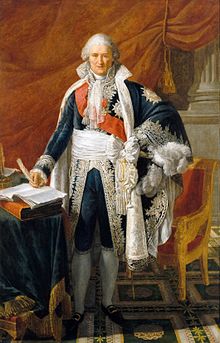Jean-Étienne-Marie Portalis

Jean-Étienne-Marie Portalis (1 April 1746 – 25 August 1807) was a French
Biography
Early years
Portalis was born at
In 1765 he became a
Revolution
In November 1793, after the
On being released he practised as a lawyer in Paris, and, in 1795, he was elected by the capital to the
Under Napoleon
Bonaparte made him a
In 1801 he was placed in charge of the Department of Religion or Public Worship, and in that capacity had the chief share in drawing up the provisions of the
References
- ^ "Jean-Étienne-Marie Portalis | Napoleonic Code, Code Civil & French Revolution | Britannica". www.britannica.com. Retrieved 2024-02-22.
- ^ a b c d Chisholm 1911, p. 110.
- ^ "Jean-Étienne-Marie Portalis | Napoleonic Code, Code Civil & French Revolution | Britannica". www.britannica.com. Retrieved 2024-02-22.
- ^ Chisholm 1911, pp. 110–111.
- This article incorporates text from a publication now in the public domain: Chisholm, Hugh, ed. (1911). "Portalis, Jean Étienne Marie". Encyclopædia Britannica. Vol. 22 (11th ed.). Cambridge University Press. pp. 110–111. In turn, it cites as references:
- Oeuvres by F. Portalis (1823)
- Frederick Portalis, Documents, rapports, et travaux inédits sur le Code Civil (1844); Sur le Concordat (1845)
- René Lavole, Portalis, sa vie et ses œvres (Paris, 1869)

